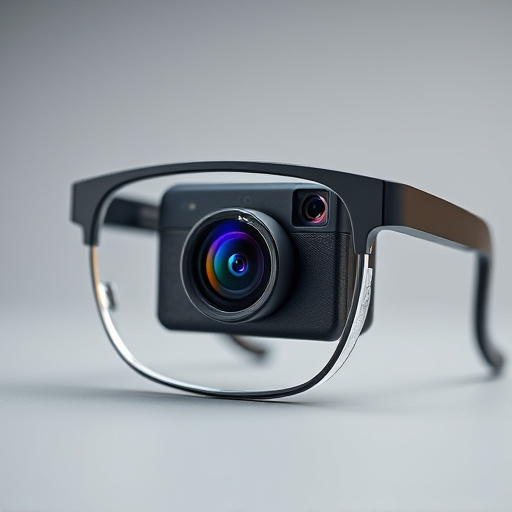Glasses with a camera built-in (smart or spy glasses) seamlessly blend optics and digital capabilities, allowing discreet photo and video capture. Popular for surveillance, security, and personal use, these devices offer real-time streaming, GPS tracking, gesture control, and smartphone connectivity. While versatile, their clandestine nature raises legal and ethical concerns regarding privacy and potential misuse, highlighting the need for responsible usage guidelines and regulations. This technology promises to revolutionize visual content creation by providing hands-free, accessible recording capabilities for enhanced security, surveillance, and documentation in various fields.
Glasses with a camera built-in, often referred to as spy glasses, have emerged as versatile and discreet surveillance tools. This article delves into the world of these innovative devices, exploring their functionality, diverse features, and real-world applications. We’ll examine how these hidden cameras operate, the legal and ethical considerations surrounding their use, and the various types available on the market. Get ready to uncover the secrets behind this modern technology.
What are Glasses with a Camera Built-in?
Glasses with a camera built-in, often referred to as smart glasses or spy glasses, are innovative wearable devices that blend optics and technology seamlessly. These glasses incorporate tiny cameras into their frames, allowing users to capture photos and videos discreetly and hands-free. The cameras can be hidden within the lenses or integrated into the bridge of the glasses, making them virtually invisible to onlookers. This feature makes them popular choices for surveillance, security, and personal use.
With the touch of a button or a voice command, users can activate the camera, providing a unique perspective from their point of view. These devices often offer real-time video streaming capabilities, enabling wearers to share experiences instantly. Additionally, they may include other functions like GPS tracking, gesture control, and connectivity to smartphones, tablets, or computers, enhancing their versatility in various scenarios.
How Do These Spy Glasses Work?
Spy glasses, also known as hidden cameras or surveillance glasses, are an innovative tool that combines optical technology with advanced digital capabilities. These glasses feature a camera discreetly built into their frames, allowing users to capture high-definition video or take photos without drawing attention. The process involves a complex interplay of optics and electronics; the camera captures images through the lenses, which are then processed by an internal microcontroller. This compact hardware enables real-time transmission of footage to a connected device, such as a smartphone or computer, for immediate viewing or subsequent analysis.
The functionality is designed to be seamless and unnoticeable. Users can simply put on the glasses and start recording, making them ideal for various applications, including surveillance, security, and even personal use. With their compact size and discreet design, these glasses with a camera built-in offer a unique perspective, quite literally, on situations that require observation or documentation without alerting others to their presence.
Types and Features of Hidden Cameras in Glasses
Glasses with a camera built-in come in various types, each offering unique features tailored for different purposes. One common type is the hidden camera glasses, designed to look like regular eyewear but equipped with discreet cameras capable of capturing high-resolution videos and photos. These cameras often have auto-focus capabilities and can record video in HD or even 4K quality, making them ideal for surveillance and security applications.
Another variant is the smart glasses with integrated cameras, which offer advanced features such as hands-free control, voice activation, and live streaming capabilities. These glasses are not only functional but also stylish, featuring lightweight frames and adjustable nosepieces for comfortable wear. They can be used for various activities, from capturing memorable moments to professional video conferencing in virtual reality settings.
Legal Considerations and Ethical Implications
The use of spy glasses equipped with cameras raises significant legal and ethical concerns. In many jurisdictions, recording video or taking photos without consent is illegal, especially in private spaces. Wearing hidden cameras in the form of glasses can easily infringe upon personal privacy, leading to potential lawsuits and criminal charges if used inappropriately.
Additionally, the ethical implications are profound. Spy glasses with a camera built-in can be seen as an invasion of privacy, fostering a culture of surveillance. This technology may encourage misuse, such as stalking, harassment, or unlawful monitoring, leading to severe psychological and emotional distress for victims. As such, responsible use and clear regulations are necessary to ensure these devices do not become tools for unethical behavior.
Real-world Applications and Use Cases
In the real world, glasses with a camera built-in have found their place in various applications beyond mere spy fiction. These innovative devices offer unique advantages in fields like security and surveillance, offering discreet and hands-free recording capabilities. For instance, they can be utilized by security personnel to monitor high-risk areas or by journalists embedded in dangerous zones to capture unfiltered footage.
In everyday life, these glasses can serve as powerful tools for documentation and evidence collection. They are especially useful in scenarios where a person’s hands are occupied, such as during interviews or demonstrations, allowing wearers to easily record essential information without compromising their interactions. This technology has the potential to revolutionize how we capture and share visual content, making it more accessible and versatile than traditional cameras.
